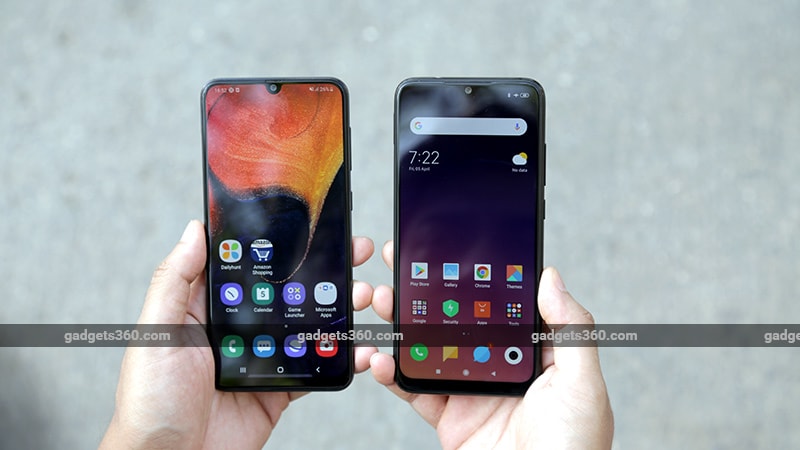- Home
- Mobiles
- Mobiles Features
- Redmi Note 7 Pro vs Samsung A50: Camera, Performance, Battery Life Comparison
Redmi Note 7 Pro vs Samsung A50: Camera, Performance, Battery Life Comparison

Samsung A50 (left) and the Redmi Note 7 Pro go head to head — who comes out ahead? Read on
When we compared the Redmi Note 7 Pro with the Samsung Galaxy M30, the former emerged as the clear winner for most users. It offers a fast Qualcomm Snapdragon 675 SoC, all-day battery life, and good cameras. However, getting your hands on a Redmi Note 7 Pro is quite hard thanks to the company's periodic flash sales. Naturally, you might want to look at other smartphones at around the same price point, and one phone that will pop up on the list is the Samsung Galaxy A50. Yes, It is more expensive than the Redmi Note 7 Pro, but it is readily available and has an in-display fingerprint scanner, which isn't common at this price point. So between the elusive Redmi Note 7 Pro and the Samsung Galaxy A50, which one should you pick? We test them head-to-head to find out.
Redmi Note 7 Pro vs Samsung A50 design
While both these smartphones are priced in roughly the same ballpark, their build quality is quite different. Let's first talk about the Samsung Galaxy A50 (Review), which looks appealing thanks to its translucent grey back which has an iridescent finish. However, it feels plasticky compared to the Corning Gorilla Glass 5 panel on the Redmi Note 7 Pro (Review).
With that said, the Samsung Galaxy A50 is slimmer and has thinner bezels around its screen. Pick the two phones up and you will instantly feel that the Samsung Galaxy A50 is also lighter. The Redmi Note 7 Pro on the other hand is thicker and feels heavier. Button placement is identical on both phones, and we had to stretch to reach the volume buttons on both. You won't be second guessing an input on either phone thanks to their clicky feel though.
Both phones have waterdrop notches, but the one on the Samsung Galaxy A50 is smaller. Turn the phones around and you will see the triple camera setup on the Samsung Galaxy A50 while the Redmi Note 7 Pro has a dual camera setup. You'll find a rear mounted fingerprint scanner on the Redmi Note 7 Pro, whereas the Galaxy A50 uses an in-display fingerprint scanner.
![]() The Redmi Note 7 Pro has a more premium glass back, while the Samsung Galaxy A50 has the better style
The Redmi Note 7 Pro has a more premium glass back, while the Samsung Galaxy A50 has the better style
Thankfully, both phones have modern USB Type-C ports as well as 3.5mm headphone jacks. The Redmi Note 7 Pro has a slight advantage in the form of an IR emitter which can be used to control appliances.
In terms of design we call a tie between these two phones since the Samsung Galaxy A50 has the better style, while the Redmi Note 7 Pro uses more premium materials.
Redmi Note 7 Pro vs Samsung A50 specifications, software, and features
The spec sheets of these two devices reveal how different they are. Samsung's contender, the Galaxy A50, has a 6.4-inch Super Amoled screen with a full-HD+ resolution and an in-display fingerprint scanner. The Redmi Note 7 Pro has a 6.3-inch LTPS In-Cell display with a full-HD+ resolution. Both screens are good to look at but it is Samsung's Super AMOLED panel that produces the better output between the two.
Each manufacturer has taken a different approach when it comes to the processor. Samsung has opted for its own Exynos 9610 octa-core SoC and has matched it with 4GB of RAM and 64GB of storage. A more expensive variant with 6GB of RAM is also available, but the storage remains the same. Samsung has priced the lower variant at Rs. 19,990 while the higher one will cost you Rs. 22,990.
Xiaomi is the first manufacturer to offer the Qualcomm Snapdragon 675 octa-core SoC, and this phone also offers 4GB of RAM with 64GB of storage. If you opt for the higher priced variant, you get 6GB of RAM and 128GB of storage. Pricing is more attractive than Samsung's options, with the base variant priced at Rs. 13,999 while the higher-end one will set you back by Rs. 16,999.
![]()
If you want to expand storage, both smartphones give you the option to do that. The Samsung Galaxy A50 has a dedicated microSD card slot that allows expansion by up to 512GB, but with the Note 7 Pro you get a hybrid slot which allows expansion by up to 256GB, so you'll have to sacrifice a second SIM. Both phones have 4000mAh batteries, but the Galaxy A50 gets a 15W charger in the box while the Redmi Note 7 Pro comes with a 10W charger. Xiaomi does offer support for Qualcomm's Quick Charge 4.0 technology but you will have to buy a compatible charger separately.
Connectivity options on the Samsung Galaxy A50 include Bluetooth, Wi-Fi, FM radio, and 4G as well as VoLTE on both SIMs. The Redmi Note 7 Pro offers Bluetooth 5, dual-band Wi-Fi, dual 4G and VoLTE, and IR.
In terms of software, you get the latest Android 9 Pie running on both smartphones. Samsung ships its custom One UI on top, while Xiaomi has its own MIUI 10. We found that the Galaxy A50 had received the recent March 2019 security patch while the Redmi Note 7 Pro was on the February patch.
Each UI has its own set of features, but we prefer OneUI over MIUI because it looks fresh and is closer to stock Android. We were annoyed with spammy notifications on both smartphones, and had to go about disabling notifications and uninstalling a few apps.
How to Remove Ads From Your Xiaomi Phone
Redmi Note 7 Pro vs Samsung A50 cameras, performance, and battery life
Both phones are powerful enough to run day-to-day tasks without breaking a sweat. We could multitask easily with apps in the background and did not face any issues on either device. We found that while both phones let us multitask easily, the Redmi Note 7 Pro was marginally quicker when launching apps. You'll notice this only if you compare the two side-by-side.
The Samsung Galaxy A50's in-display fingerprint scanner will be a big draw for a lot of people, but it isn't as quick to unlock the smartphone as the capacitive sensor on the Redmi Note 7 Pro. We also tried face recognition, which is available on both phones, and found that both can be unlocked at the same speed.
Raw performance is a deciding factor for a lot of people when buying a smartphone, so let the benchmark numbers do the talking. In AnTuTu, the Samsung Galaxy A50 managed to clock 145,408 points, while the Redmi Note 7 Pro scored 178,570 points. After running Geekbench 4, the Galaxy A50 returned 1,719 in the single-core test and 5,586 in the multi-core test, while the Redmi Note 7 Pro managed 2,389 and 6,593 respectively. The Redmi Note 7 Pro also did well in graphics benchmarks, with 41fps in GFXBench's T-Rex scene and 15fps in Manhattan 3.1. The Samsung Galaxy A50 scored 37fps and 22fps respectively.
We played PUBG Mobile on both phones to check their gaming performance. The Redmi Note 7 Pro loads the game quicker than the Samsung Galaxy A50. After playing on both phones for 15 minutes with the graphics set to Balanced and the frame rate set to High, the battery level on the Redmi Note 7 Pro dropped by 5 percent, while the Samsung Galaxy A50's battery level dropped by 4 percent. We also found that the Redmi Note 7 Pro had gotten warmer than the Galaxy A50, which makes Samsung's offering potentially a better pick for extended gaming sessions.
![]()
Both smartphones have a 4000mAh batteries, and lasted for over a day with regular usage. In our HD video loop test, the Samsung Galaxy A50 went on for 14 hours and 59 minutes while the Redmi Note 7 Pro went on for 19 hours and 23 minutes. However, the Galaxy A50 was quicker to charge completely thanks to the bundled 15W charger, compared to the 10W one that Xiaomi supplies.
The Redmi Note 7 Pro has a 48-megapixel primary camera with an f/1.79 aperture, along with a 5-megapixel depth sensor. The Samsung Galaxy A50 has a triple camera setup consisting of a 25-megapixel primary camera with an f/1.7 aperture; an 8-megapixel ultra-wide-angle camera with an f/2.2 aperture and 123-degree field of view; and a 5-megapixel depth sensor. For selfies, the Redmi Note 7 Pro has a 13-megapixel sensor while the Galaxy A50 has a 25-megapixel sensor with an f/2.0 aperture.
We took multiple photos in different lighting conditions with both phones at the same time, to see how they stack up against each other. In daylight shots we noticed that the Redmi Note 7 Pro manages better details, and objects at a distance are also sharp. The Samsung Galaxy A50 lags behind slightly, but manages to render HDR better than the Redmi Note 7 Pro. Also, the wide-angle sensor on the Galaxy A50 gives it an edge in terms of flexibility when composing shots, especially of landscapes.
![]()
Both phones capture good macros and preserve a lot of detail, but we prefer the depth effect that the Redmi Note 7 Pro creates. The Samsung Galaxy A50 delivers punchier colours in comparison, thanks to the scene optimiser, which some people might prefer.
![]()
In low light, the Galaxy A50 produces a brighter image but at the cost of blowing out the highlights. The Redmi Note 7 Pro handles this slightly better, but images are noisier. The Samsung Galaxy A50 takes longer than the Redmi Note 7 Pro to lock focus in low light, but we found its shots to be better overall.
![]()
We shot a few portraits using both phones with their beautification features disabled. The Samsung Galaxy A50 gives you the option to set the level of blur, while the Redmi Note 7 Pro does not. Instead, Xiaomi offers studio lighting effects. We found that the Redmi Note 7 Pro meters light better and produces better details than the Samsung Galaxy A50.
![]()
When it comes to selfies, we found that the Redmi Note 7 Pro doesn't always get the colour tone right, but captures significantly better details than the Samsung Galaxy A50 which produced softer selfies in comparison.
![]()
Video recording maxes out at 1080p on the Samsung Galaxy A50, while the Redmi Note 7 Pro can record 4K video as well as 1080p at 60fps which are both advantages. Both smartphones have stabilisation, which helps reduce shakes.
All in all, while the Samsung Galaxy A50 is better in certain scenarios like the HDR mode and has the useful wide-angle camera, the Redmi Note 7 Pro manages to edge this thanks to its performance with daylight shots and landscapes, macro shots, as well as portraits, not to mention support for higher resolution video recording.
Verdict
These two smartphones are not in the exact same price range, as the Galaxy A50 commands a premium over the Redmi Note 7 Pro. However, the Galaxy A50 has more in common with the Redmi Note 7 Pro than the Galaxy M30 (Review), as we found when we compared them. Samsung offers a better Super AMOLED panel, an in-display fingerprint scanner, and its software is more up to date.
The Redmi Note 7 Pro has a more powerful processor and cameras that perform better in majority of the scenarios. You will also save a few thousand rupees if you choose this phone over the Samsung Galaxy A50 (Review).
Unfortunately, getting your hands on a Redmi Note 7 Pro isn't going to be easy right now as it is only available in limited quantities through flash sales. If you don't want to struggle with such sales and don't mind paying a premium, the Samsung Galaxy A50 will not disappoint you either.
Do Redmi Note 7 Pro, Redmi Note 7, and Mi Soundbar redefine their price segments? We discussed this on Orbital, our weekly technology podcast, which you can subscribe to via Apple Podcasts or RSS, download the episode, or just hit the play button below.
Get your daily dose of tech news, reviews, and insights, in under 80 characters on Gadgets 360 Turbo. Connect with fellow tech lovers on our Forum. Follow us on X, Facebook, WhatsApp, Threads and Google News for instant updates. Catch all the action on our YouTube channel.
Related Stories
- Samsung Galaxy Unpacked 2025
- ChatGPT
- Redmi Note 14 Pro+
- iPhone 16
- Apple Vision Pro
- Oneplus 12
- OnePlus Nord CE 3 Lite 5G
- iPhone 13
- Xiaomi 14 Pro
- Oppo Find N3
- Tecno Spark Go (2023)
- Realme V30
- Best Phones Under 25000
- Samsung Galaxy S24 Series
- Cryptocurrency
- iQoo 12
- Samsung Galaxy S24 Ultra
- Giottus
- Samsung Galaxy Z Flip 5
- Apple 'Scary Fast'
- Housefull 5
- GoPro Hero 12 Black Review
- Invincible Season 2
- JioGlass
- HD Ready TV
- Laptop Under 50000
- Smartwatch Under 10000
- Latest Mobile Phones
- Compare Phones
- Huawei Nova 15
- Huawei Nova 15 Pro
- Huawei Nova 15 Ultra
- OnePlus 15R
- Realme Narzo 90x 5G
- Realme Narzo 90 5G
- Vivo S50 Pro Mini
- Vivo S50
- Asus ProArt P16
- MacBook Pro 14-inch (M5, 2025)
- Huawei MatePad 11.5 (2026)
- OnePlus Pad Go 2 (5G)
- OnePlus Watch Lite
- Just Corseca Skywatch Pro
- Acerpure Nitro Z Series 100-inch QLED TV
- Samsung 43 Inch LED Ultra HD (4K) Smart TV (UA43UE81AFULXL)
- Asus ROG Ally
- Nintendo Switch Lite
- Haier 1.6 Ton 5 Star Inverter Split AC (HSU19G-MZAID5BN-INV)
- Haier 1.6 Ton 5 Star Inverter Split AC (HSU19G-MZAIM5BN-INV)



















